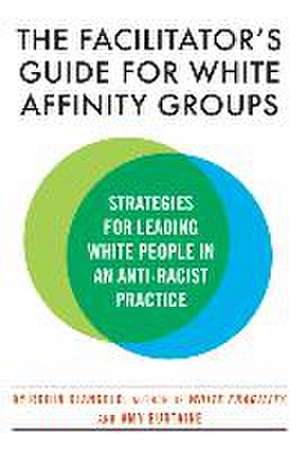The Facilitator's Guide for White Affinity Groups: Strategies for Leading White People in an Anti-Racist Practice
Autor Robin Diangelo, Amy Burtaineen Limba Engleză Paperback – 9 aug 2022
Preț: 117.95 lei
Nou
Puncte Express: 177
Preț estimativ în valută:
22.57€ • 23.42$ • 18.87£
22.57€ • 23.42$ • 18.87£
Carte disponibilă
Livrare economică 22 februarie-08 martie
Livrare express 08-14 februarie pentru 29.80 lei
Preluare comenzi: 021 569.72.76
Specificații
ISBN-13: 9780807003565
ISBN-10: 0807003565
Pagini: 224
Dimensiuni: 151 x 226 x 18 mm
Greutate: 0.3 kg
Editura: Beacon Press
ISBN-10: 0807003565
Pagini: 224
Dimensiuni: 151 x 226 x 18 mm
Greutate: 0.3 kg
Editura: Beacon Press
Notă biografică
Dr. Robin DiAngelo is an affiliate associate professor of education at the University of Washington. She has been a consultant, educator, and facilitator on issues of racial and social justice for more than twenty-five years. She is the author or coauthor of several books, including the New York Times bestsellers White Fragility and Nice Racism. Find her online at robindiangelo.com.
Amy Burtaine has been co-facilitating workshops, providing coaching and mediation, and educating through an anti-oppression lens for over 20 years. While she has experience leading this work on a range of oppressions, her passion and commitment is to center race, specifically looking at how whiteness upholds and perpetuates racial inequality. She most often works in collaboration with people of color to co-facilitate dialogues and trainings on racism. She holds a MFA and is trained in interactive pedagogy. Find her online at amyburtaine.com.
Amy Burtaine has been co-facilitating workshops, providing coaching and mediation, and educating through an anti-oppression lens for over 20 years. While she has experience leading this work on a range of oppressions, her passion and commitment is to center race, specifically looking at how whiteness upholds and perpetuates racial inequality. She most often works in collaboration with people of color to co-facilitate dialogues and trainings on racism. She holds a MFA and is trained in interactive pedagogy. Find her online at amyburtaine.com.
Cuprins
INTRODUCTION
Why White Affinity Groups?
CHAPTER 1
The Basics
CHAPTER 2
Different Contexts
CHAPTER 3
Getting Started
CHAPTER 4
Prompts, Discussion Starters, and Facilitator Techniques
CHAPTER 5
Addressing Common Patterns and Challenges
PATTERNS WE SEE BEFORE GETTING TO OUR WHEN STARTING THE AFFINITY GROUP
1. Resistance to Breaking into Separate Groups
2. “I’m Not White”
PATTERNS RELATED TO WHITE IDENTITY
3. Expecting People of Color to Teach Us About Race
4. Expecting Answers
5. Fear of Being Perceived as Racist
6. Taking Everything Personally
7. Claiming Racial Innocence
8. Cat on a Hot Tin Roof
9. The Confessional
10. Critiquing the Thinking of People of Color
11. Intellectualizing
PATTERNS RELATED TO THE DENIAL OF RACISM
12. “It’s Different Where I Come From”
13. Removing Race from the Equation
14. Distancing
15. Claiming Reverse Racism: “They’re Just as Racist as We Are”
PATTERNS RELATED TO GROUP DYNAMICS
16. Checking Out
17. Dominating the Discussion
18. Out-Woking
19. Silence
20. Scapegoating
21. Fear of Challenging Others in the Group
22. Power Dynamics Rooted in Rank
23. Where Is Everyone?
24. The Closing Bomb
PATTERNS RELATED TO THE FACILITATORS
25. The Difficult Participant
26. Challenging the Facilitators
27. Trying to Facilitate from Within the Group
28. “Show Me the Agenda”
29. Feeling Entitled to the Facilitators’ Time
30. The Kiss-Up
31. The Pile-On
PATTERNS WE WORK ON HERE SO WE DON’T ENGAGE IN THEM WHEN IN MIXED GROUPS
32. Credentialing
33. Hopelessness
34. Hopefulness
35. Complaining about How Exhausting the Work Is
36. Channel Changing
37. White Fragility
38. Getting Stuck in Guilt/Shame
39. Centering Our Own Trauma
40. “I’m Powerless”
41. White Women’s Tears
42. The Extreme
CHAPTER 6
Closing the Group
CHAPTER 7
Accountability
Glossary
Additional Resources for Your Anti-Racist Practice
Acknowledgments
Notes
Why White Affinity Groups?
CHAPTER 1
The Basics
CHAPTER 2
Different Contexts
CHAPTER 3
Getting Started
CHAPTER 4
Prompts, Discussion Starters, and Facilitator Techniques
CHAPTER 5
Addressing Common Patterns and Challenges
PATTERNS WE SEE BEFORE GETTING TO OUR WHEN STARTING THE AFFINITY GROUP
1. Resistance to Breaking into Separate Groups
2. “I’m Not White”
PATTERNS RELATED TO WHITE IDENTITY
3. Expecting People of Color to Teach Us About Race
4. Expecting Answers
5. Fear of Being Perceived as Racist
6. Taking Everything Personally
7. Claiming Racial Innocence
8. Cat on a Hot Tin Roof
9. The Confessional
10. Critiquing the Thinking of People of Color
11. Intellectualizing
PATTERNS RELATED TO THE DENIAL OF RACISM
12. “It’s Different Where I Come From”
13. Removing Race from the Equation
14. Distancing
15. Claiming Reverse Racism: “They’re Just as Racist as We Are”
PATTERNS RELATED TO GROUP DYNAMICS
16. Checking Out
17. Dominating the Discussion
18. Out-Woking
19. Silence
20. Scapegoating
21. Fear of Challenging Others in the Group
22. Power Dynamics Rooted in Rank
23. Where Is Everyone?
24. The Closing Bomb
PATTERNS RELATED TO THE FACILITATORS
25. The Difficult Participant
26. Challenging the Facilitators
27. Trying to Facilitate from Within the Group
28. “Show Me the Agenda”
29. Feeling Entitled to the Facilitators’ Time
30. The Kiss-Up
31. The Pile-On
PATTERNS WE WORK ON HERE SO WE DON’T ENGAGE IN THEM WHEN IN MIXED GROUPS
32. Credentialing
33. Hopelessness
34. Hopefulness
35. Complaining about How Exhausting the Work Is
36. Channel Changing
37. White Fragility
38. Getting Stuck in Guilt/Shame
39. Centering Our Own Trauma
40. “I’m Powerless”
41. White Women’s Tears
42. The Extreme
CHAPTER 6
Closing the Group
CHAPTER 7
Accountability
Glossary
Additional Resources for Your Anti-Racist Practice
Acknowledgments
Notes
